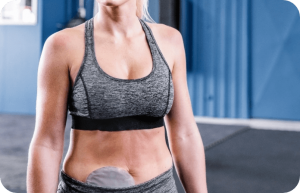Parkinson’s is a progressive neurological disorder. There is no known cure for it at present and it is not yet understood why people get this condition. The associated symptoms, however, can cause bowel incontinence and bladder problems. Parkinson’s Disease is caused by the loss of nerve cells, which contain a chemical called dopamine. Dopamine is a chemical messenger that allows us to perform coordinated movement. Levels of dopamine will gradually decrease over time, which causes a worsening of symptoms associated with Parkinson’s.
Symptoms Of Parkinson’s Disease
Parkinson’s is a complex condition that has many symptoms which vary from person to person. The three main symptoms of Parkinson’s are:
- Tremors
- Rigidity (stiff and inflexible muscles)
- Slowness of movement
Other symptoms associated with Parkinson’s include:
- Bladder problems
- Bowel incontinence
- Difficulty with eating and swallowing
- Blurred or double vision
- Fatigue
- Muscle cramps
- Difficulty with speech and communication
People with Parkinson’s Disease may also experience anxiety and depression as a result of their physical symptoms, as well as loss of memory. They may also experience difficulties with balance which can make going to the toilet more of a challenge. Support aids such as handles in the bathroom may help with this.
Bowel incontinence and Parkinson’s
- Bowel disorders are more common in people of the same age with Parkinson’s Diseas than those without. Not everyone with Parkinson’s will develop incontinence issues though. Incontinence in those with Parkinson’s is mainly caused by a disruption in the messages from the brain to the bladder or bowel. Common incontinence issues includeConstipation (overflow incontinence) and Faecal incontinence.
Bladder Incontinence and Parkinson’s
Urge incontinence and Nocturia are the most common bladder problems faced by people with Parkinson’s disease. Urge incontinence is a sudden need to use the toilet, resulting in leaks before you’re able to get there in time, whereas nocturia describes the symptom of needing to pass urine multiple times during the night. Both can be a frustration, in addition to other Parkinson’s disease symptoms.
There are still ways of managing bladder incontinence and bowel problems caused by Parkinson’s by using conservative methods. These can be easily incorporated into a routine during the day.
Parkinson’s And Incontinence Treatments
There are some preventative measures that can help avoid or improve bowel incontinence symptoms or bladder problems. It is a good idea to establish the below methods into a daily routine to train the bladder and bowel into a regular pattern. Some doctors and healthcare practitioners also recommend keeping a diary to help monitor and track symptoms.
The information that follows includes conservative treatments – to address at-home options, medicinal treatments for Parkinson’s as well as surgical options.
CONSERVATIVE TREATMENTS
Diet And Lifestyle
In order to manage Parkinson’s Disease, it’s important to keep the bladder and bowel healthy. Try to ensure that a healthy, balanced diet is consumed with plenty of fibre and enough fluid (ideally water and around 6-8 glasses a day). This will help to regulate the bowel and keep stools at the right consistency. A diet for Parkinson’s, as for general health, should limit or avoid caffeine, fizzy drinks and alcohol as these can irritate the bladder.
Establish Routines
An active lifestyle can aid bowel health and help manage bladder conditions for Parkinson’s. Creating a routine can help to avoid accidents; it can help to go to the toilet after every meal and eat and drink at regular times. Limit drinks two hours before bedtime to avoid accidents overnight, it is important to make sure that enough fluid has been consumed during the day though, so just make sure you drink enough earlier in the day.
Appropriate Clothing
Clothing that can be easily removed, elasticated waists without zips and buttons can help those who struggle with their dexterity or have slowness of movement are useful for those who have urge incontinence.
Bathroom Adaptations
It may be helpful to look at what adaptations can be done in the home to help those with mobility or balance issues. Hand rails, toilet frames, adjusting the height on the toilet seat and footstools are easy to add into the home and can help.
Continence Products
There are many continence products available that can help someone with Parkinson’s to feel more comfortable and will protect clothing and furniture.
- Incontinence pads and pants – these are available in a variety of sizes and absorbencies and can help to draw fluid away from the skin.
- Male continence sheath – these can be worn over the penis and attached to a leg bag. These are particularly useful at night.
- Bed pads and mattress protectors – these can help to keep the bed clean and dry. There are also covers and pads available for chairs.
- Intermittent catheterisation may also be considered to ensure urine is properly drained from the bladder, several times per day.
Visit the Bladder & Bowel Home Delivery Service for more information and to order these products. Our caring, specially trained advisors can help you decide which option is most suitable for you.
Indwelling Catheterisation
If urinary incontinence is quite severe than long term catheterisation may be a better way to manage your bladder, and an indwelling catheter is one option. This involves inserting a fine tube through the urethra up into the bladder. This can be attached to either a valve or a drainage bag. The catheter will need to be replaced every few weeks.
MEDICINAL
Laxatives
To relieve short term constipation quickly, there are some over-the-counter laxatives that can be purchased. These can be used in order to avoid impaction of the bowel and any overflow incontinence as a result.
There are a variety of laxatives available that act in different ways.
- Bulking laxatives such as Fybogel, which work in the same way as increasing fibre in their diet;
- osmotic laxatives, which work by softening the stool making it easier to pass
- stimulant laxatives such as senna, which encourages peristalsis and stimulates the gut to pass the stool.
Make sure that you speak to your local pharmacist or GP about which type of laxative is best to use.
Parkinson’s Medication
There are various drugs and medications available to treat the symptoms of Parkinsons, which someone with the disease may need to control symptoms. These will do one of the following:
- Control dopamine levels in the brain
- Act as a substitute for dopamine
- Reduce or block the enzymes responsible for breaking down the dopamine in the first place
You can find out more about these medications at parkinsons.org.uk
SURGICAL
Suprapubic Catheterisation
A suprapubic catheter is an alternative form of long term catheterisation and involves a small surgical procedure to place a tube directly into your bladder through your abdomen. Again you can attach the tube to a valve or a drainage bag.This should only be considered if other treatment options have been unsuccessful, as there are always risks with surgery. Speak to your GP or consultant if you feel you’ve exhausted other options.
THE INFORMATION ON THIS PAGE IS A GUIDE ONLY. IT IS IMPORTANT THAT YOU SPEAK TO YOUR GP OR A QUALIFIED HEALTH PROFESSIONAL BEFORE UNDERTAKING ANY TREATMENTS.
Further information
Downloads can be found in the help and information section. Parkinson’s UK is the main Parkinson’s support and research charity in the UK, and offer many levels of support including maintaining relationships, managing finance, and more information on symptoms and treatments. They can help if you’re living with the disease and let you know about support groups in the area.
Living with a bladder or bowel condition or caring for someone with a bladder and bowel condition can affect you emotionally and socially; sometimes it can help to speak to others who understand your situation. The Bladder & Bowel Community Support Group is available 24 hours today and will allow you to connect with those who share your condition. Start your own topic today or just follow one that interests you..





